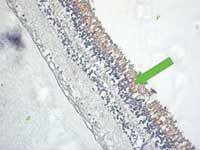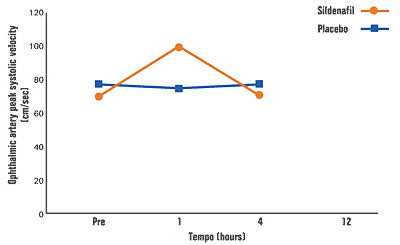PDE inhibitors show promise in AMD treatment
Because of their vasodilating effects, these drugs offer a potential ‘breakthrough’ in the treatment of hypoperfusion-related ocular pathologies.
Despite their potentially harmful side effects, phosphodiesterase inhibitors continue to raise interest among eye specialists because of their promising therapeutic results.
Phosphodiesterase (PDE) inhibitors, namely Viagra (sildenafil, Pfizer), Levitra (vardenafil, Bayer) and Cialis (tadalafil, Eli Lilly), have been introduced in recent years for the treatment of erectile dysfunction. Ocular side effects such as minor and transient visual disturbances, but also, in rare cases, branch retinal vein occlusion and anterior ischemic optic neuropathy already have been reported in the literature. Due to their vasodilating effects, however, these medications are now being studied as potentially potent pharmacological agents in the treatment of hypoperfusion-related ocular pathologies, such as diabetic retinopathy and AMD.
“The use of these medications has helped us discover that various functions of the body are mediated by the PDEs,” said Luigi Caretti, MD, of the Sant’Antonio Hospital in Padua, Italy. “In a study that we are currently undertaking, we have found that both PDE5 and PDE6 are highly expressed in the human eye, and we are now investigating their functions and the potential implications of their pharmacological inhibition.
“We have a long way to go, but once these mechanisms are clear, the therapeutic use of PDE inhibitors may become feasible. Currently, we don’t have proper vasodilators for the eye, and these molecules, properly modified, could become a real breakthrough in the treatment of ocular disorders related to the chronic reduction of blood flow,” he said.
|
|
Images: Caretti L |
Effects of PDE inhibitors
Penile erection is strictly dependent on the increased production of cyclic guanosine monophosphate (cGMP), which causes the relaxation and dilation of the smooth muscles in the blood vessels of the corpora cavernosa penis. A specific family of enzymes, the PDE5, catalyses the degradation of cGMP, reducing vasodilation and arresting the erection.
“Sildenafil, vardenafil and tadalafil are potent PDE inhibitors, with a 100% selectivity for PDE5. They antagonize the degradation of cGMP, maintaining elevated levels of this nucleotide and therefore allowing and prolonging penile erection,” Dr. Caretti said.
Recent studies found that in mammal eyes, two families of PDEs, PDE5 and PDE6, are present in the photoreceptors of the retina.
“In our study, using molecular biology and immunohistochemical procedures, we’ve been the first to provide evidence that the PDE5 is also highly expressed in the human eye, particularly at the retinal level. PDE6 is also present, though in a lesser quantity,” he said.
According to Dr. Caretti, this explains why PDE5-selective inhibitors, which were also found to have a 10% affinity with PDE6, may cause important modifications in the human eye. The inhibition of PDE6 is probably responsible for the transient visual disturbances that have been found in about 3% of the patients using these medications. The inhibition of PDE5, however, is bound to have effects on the nerves and blood vessels of the retina and choroids, he said.
“We know little of these effects, but there are strong analogies between the choroid and the corpus cavernosum penis. The nerves and blood vessels in both tissues are anatomically and histologically similar, and therefore have a similar functional mechanism.”
Effects on ocular vascular flow
The effects of PDE inhibitors on the ocular vascular flow were evaluated by Dr. Caretti and colleagues in 40 male patients using the ecocolordoppler. Patients were randomly assigned to three groups receiving a single dose of one of the three PDE-inhibiting molecules and compared with controls receiving a single dose of placebo. The ophthalmic artery peak systolic velocity and the small posterior ciliary arteries peak systolic velocity were measured over several hours.
“A single dose of sildenafil progressively vasodilated the ophthalmic artery, reaching the peak at 1 hour. This was followed by a slow decrease, returning to baseline at 4 hours after administration,” Dr. Caretti said.
He said this pattern coincides exactly with the effects of Viagra on penis erection, reaching its peak at 1 hour and wearing off at 4 hours. No variation in the artery blood flow was observed with the placebo.
Identical results were obtained with vardenafil, while the blood flow of controls remained unaltered.
“The effects of tadalafil were considerably more long-lasting. The peak was at 1 hour, followed by a slow decrease over the following 35 hours. This also coincides with the effects of the drug on penis erection. Again, no variation was reported in the control group,” Dr. Caretti said.
In summary, PDE inhibitors were shown to increase the vascular flow of ocular blood vessels, and the time of vasodilation is strictly correlated with the half-life of the drug. Once the drug is eliminated from the organism, the vasodilating effect ceases.
|
Future developments
Further studies should be undertaken to investigate the reasons of such a diffused presence of the PDEs in the eye. Dr. Caretti and colleagues are planning a series of electrofunctional tests, which might help them gain an understanding of the role of these enzymes in the neuronal cells of the retina.
“A better understanding of the role of these enzymes also will help us to understand the consequences of their inhibition and to have a better control of the side effects,” Dr. Caretti said.
In the meantime, these findings should increase the awareness that these medications must be used with caution and under medical surveillance. According to official data, 7 million people use these drugs worldwide, but the companies say those numbers are much higher.
“The visual function should always be accurately monitored in these patients,” Dr. Caretti recommended, “and the side effects should never be underestimated.”
The next step would be to set up clinical trials investigating the therapeutic properties of PDE inhibitors in ophthalmology.
“The perspective of finding a new pharmacological agent for the treatment of AMD is particularly intriguing, considering the high number of people affected by this disease,” Dr. Caretti said. Other indications might be several forms of retinal and optic nerve disorders, and even glaucoma.
“Increased blood flow could reduce the concentration of the catabolites that accumulate in the glaucomatous eye,” he said.
For more information:
- Luigi Caretti, MD, can be reached at Ospedale SantAntonio, Via Facciolati 71, 35127 Padua, Italy; +39-049-8216729; fax: +30-049-8216448; e-mail: gigicaret@libero.it.
- Michela Cimberle is an OSN Correspondent based in Treviso, Italy, who covers all aspects of ophthalmology. She focuses geographically on Europe.





